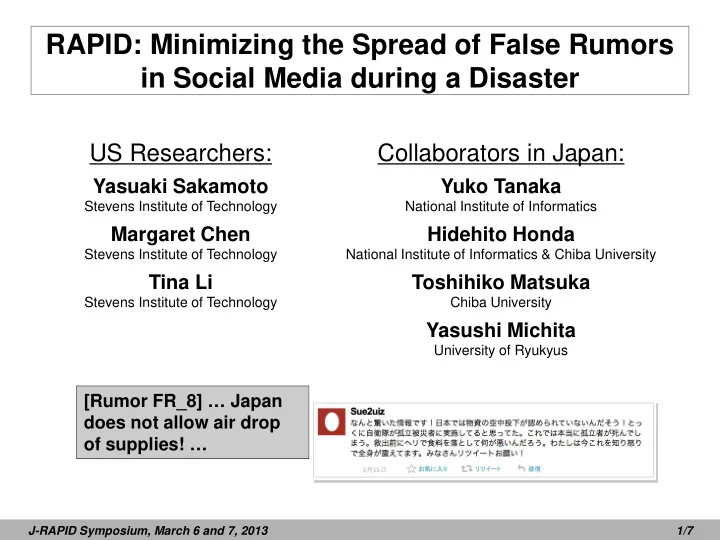

RAPID: Minimizing the Spread of False Rumors in Social Media during a Disaster US Researchers: Collaborators in Japan: Yasuaki Sakamoto Yuko Tanaka Stevens Institute of Technology National Institute of Informatics Margaret Chen Hidehito Honda Stevens Institute of Technology National Institute of Informatics & Chiba University Tina Li Toshihiko Matsuka Stevens Institute of Technology Chiba University Yasushi Michita University of Ryukyus [Rumor FR_8] … Japan does not allow air drop of supplies! … J-RAPID Symposium, March 6 and 7, 2013 1/7
J-RAPID Symposium, March 6 and 7, 2013 2/7
Goal: To find effective methods for minimizing the spread of false information in social media through better understanding information-sharing behavior Example 1: People’s sharing of true vs. debatable vs. false statements -People are less likely to pass false statements. -Good news, but people can’t tell that false rumors are false. -What if we tell people? J-RAPID Symposium, March 6 and 7, 2013 3/7
Method 1: Exposure to tweets that criticize false tweets [Criticism] Air drop is not [Rumor FR_8] … Japan prohibited. Don’t spread does not allow air drop of false information. … supplies! … J-RAPID Symposium, March 6 and 7, 2013 4/7
Example 2: Relationship between perception and sharing -Classic model in rumor psychology: spread of rumor varies as a function of ambiguity, importance, and anxiety -Model 1: ambiguity and importance predicted rumor spread (Japan) -Model 2: anxiety and fluency predicted rumor spread (USA) -Disaster-related tweets were less anxiety-provoking and important for people in the US than for people in Japan -Can taking other’s perspective reduce the spreading of rumor? J-RAPID Symposium, March 6 and 7, 2013 5/7
Method 2: Taking another person’s perspective Self in Fukushima Other in Fukushima No instruction J-RAPID Symposium, March 6 and 7, 2013 6/7
Contributions: (1) Better understanding of factors, such as the ones in the below table, that influence information-sharing decisions in social media environments (2) Recommendations on how to reduce the spread of false information in social media such as exposing people to information that criticizes the false information and letting people think about another person during responses to disasters This project is a part of a research program that aims at developing a crowd-based system for improving the quality of information in social media. J-RAPID Symposium, March 6 and 7, 2013 7/7
RAPID: Minimizing the Spread of False Rumors in Social Media during a Disaster US PI: Yasuaki Sakamoto Stevens Institute of Technology Collaborators in Japan: Yuko Tanaka National Institute of Informatics , Hidehito Honda Chiba University & National Institute of Informatics , Toshihiko Matsuka Chiba University , Yasushi Michita University of Ryukyus Overview/Purpose of the Project: This project focuses on analyzing information-sharing behavior in social media environments to help develop and evaluate methods for minimizing the spread of false information in social media during responses to disasters. Major Outcomes: (1) Better understanding of factors that influence information-sharing decisions in social media environments (2) Recommendations on how to reduce the spread of false information in social media
Recommend
More recommend